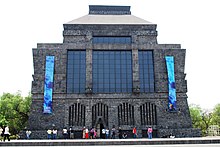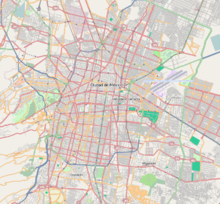Anahuacalli Museum
hideThis article has multiple issues. Please help or discuss these issues on the talk page. (Learn how and when to remove these template messages)
|
Museo Diego Rivera Anahuacalli | |
 Front view | |
 Location in Mexico City | |
| Established | 1964 |
|---|---|
| Location | Museo 150, San Pablo Tepetlapa, 04620, Coyoacán, Mexico City, Mexico |
| Coordinates | 19°19′21″N 99°08′39″W / 19.32250°N 99.14417°W |
| Architect | Juan O'Gorman and Heriberto Pagelson |
| Website | www |
The Museo Diego Rivera Anahuacalli or simply Anahuacalli Museum is a museum located in Coyoacán, in the south of Mexico City.
The museum contains 2,000 pieces from the collection of Diego Rivera. Motivated by his own interest in Mexican culture, he collected nearly 50,000 pre-Hispanic pieces during his lifetime. The Anahuacalli was completed after Rivera's death by architects Juan O'Gorman, , and Rivera's daughter, Ruth Rivera Marín.[1] Rivera and his wife, the painter Frida Kahlo, intended to build two museums as a legacy for Mexico.[2] The house that he and Kahlo lived in, known as La Casa Azul (The Blue House) now houses the Frida Kahlo Museum and is located 3.1 miles away, in the heart of the former village of Coyoacán. The twin home-studios that O'Gorman designed for the couple, in nearby San Angel, are also a museum, the House Museum Study Diego Rivera and Frida Kahlo.[3]
The Anahuacalli is a pyramid of black volcanic stone[1] (obtained from the terrain in which the Xitle volcano erupted). On the second floor, there is an exhibition room dedicated to the life and works of Rivera, as well as an observation deck.
The word Anahuacalli means "house of Anahuac" in Nahuatl.
Interior[]

The building forms a teocalli (god-house), and its design is notably influenced by the Teotihuacan culture as can be appreciated in the building’s boards, recreating the image of the rain god, Tlaloc. It also shows Maya and Aztec influences, which can be seen in the hexagonal (Maya) and rectangular (Aztec) arcs that serve as entrances to the different showrooms.
Entrance Area
Roof Terrace
Window
Entrance to the Stairwell
Solar Disk at the Museum Building
Lobby
Exposure Share
Museum Stairs
Gallery[]
Closeup of a Colored Ceramics Piece
Ceramic Sculpture of Person with Load on his Back
Death Mask of Jade
Stone and Ceramic Works
Ceramic Figurine
Ceramics Display
Ceramics Displays
Cardboard and Paper Maiche Alebrijes
Ceramic Vessel with Animal Form
Ceramic Piece
Ceramic Vessel with Distorted Face
Ceramic Sculpture of Seated Figure
Ceramic Sculpture of a Women Lacking Arms and Legs
Ceramic vessel with Woman's Head
Ceramic Funeral Mask
Figurines
Ceramic or Stone Piece with High Ceramic Relief
Museo Anahuacalli
See also[]
References[]
- ^ Jump up to: a b DK Eyewitness (2017). DK Eyewitness Mexico. DK Publishing. p. 116. ISBN 978-1-4654-6348-7.
- ^ "Museo "Historia"". Archived from the original on 29 August 2015. Retrieved 19 September 2015.
- ^ [:es: Museo Casa Estudio Diego Rivera y Frida Kahlo]
External links[]
| Wikimedia Commons has media related to Anahucalli Museum. |
Coordinates: 19°19′21″N 99°08′39″W / 19.32250°N 99.14417°W
- Museums in Mexico City
- Mesoamerican art museums
- Coyoacán
- Archaeological museums in Mexico
- Art museums and galleries in Mexico
- History museums in Mexico
- Museums established in 1964
- 1964 establishments in Mexico


























